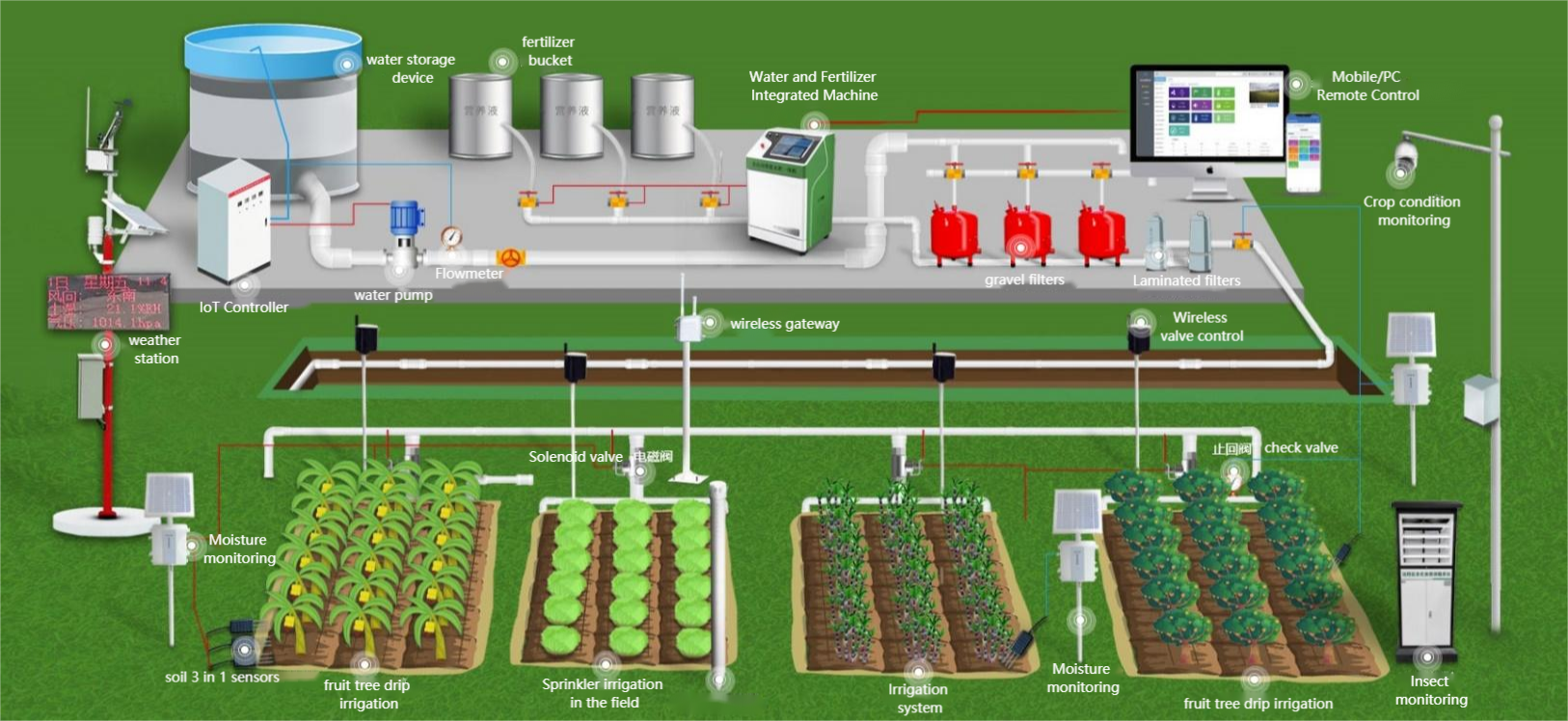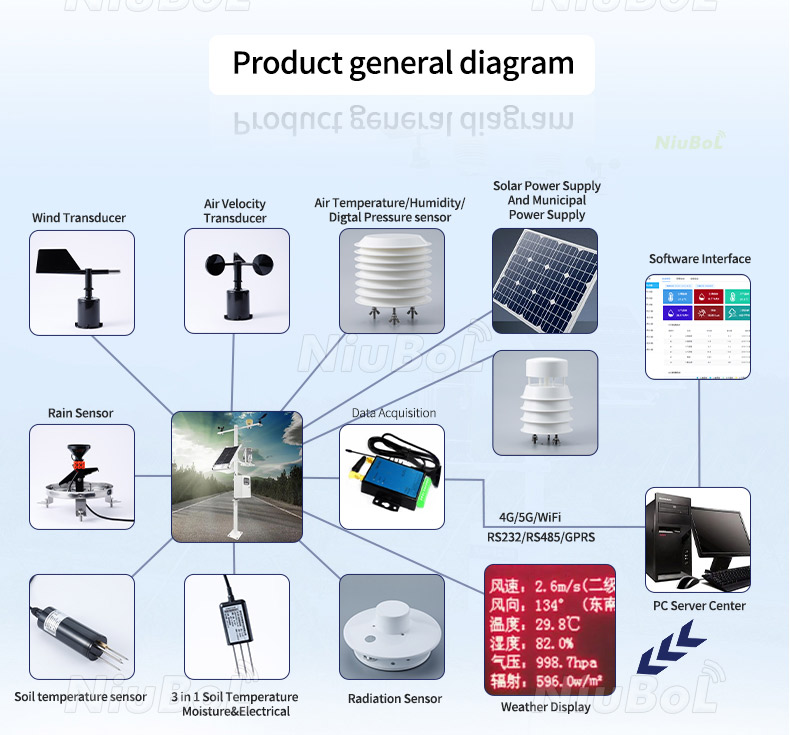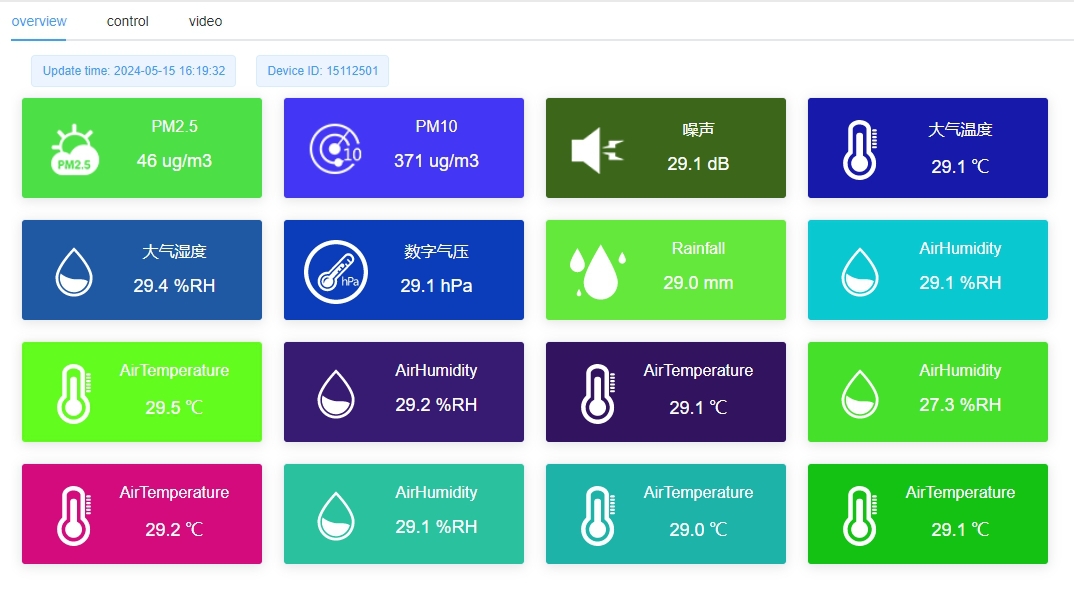

— Solutions —
—Products—
 Consumer hotline +8618073152920
Consumer hotline +8618073152920 WhatsApp:+8615367865107
Address:Room 102, District D, Houhu Industrial Park, Yuelu District, Changsha City, Hunan Province, China
Agriculture
Time:2025-11-10 17:42:23 Popularity:284
As modern agriculture transitions to digitalization and automation, farm management involves various processes such as irrigation, fertilization, climate monitoring, crop growth, and equipment maintenance. Traditional management models have the following issues:
- Managers need to inspect crop plots daily, consuming time and labor.
- Different management processes lack unified data support, making it difficult to achieve detailed management.
- Decision-making is heavily reliant on experience, leading to low water, fertilizer, and energy use efficiency.
- Abnormal events are difficult to detect and address in a timely manner.
For example, a 500-acre farm with manual management requires 6-8 hours of daily inspection, with a water and fertilizer waste rate of about 20% and a yield fluctuation of 15%.

- Complex multi-process management, high labor input: Irrigation, fertilization, climate control, pest monitoring, and other processes are independent, requiring manual recording and judgment, which is inefficient and prone to errors.
- Low water, fertilizer, and energy efficiency: Without data analysis and intelligent regulation, irrigation, fertilization, and energy consumption cannot be optimized, wasting 20-30% of water and fertilizers, and energy costs are high.
- Unable to track crop growth status in real-time: Soil moisture, crop growth indicators, and climate data cannot be unified and collected, leading to delayed problem detection and affecting yield.
- Slow response to abnormal events: Issues like valve failure, pump shutdown, or insufficient sunlight rely on manual inspections, leading to slow responses and significant losses.
- Data silos, unscientific decision-making: Data from different processes is scattered and lacks a unified analysis platform, making it difficult to make scientific decisions and long-term optimization plans.

- Achieve multi-process automation and digital management of farms.
- Improve water, fertilizer, and energy efficiency.
- Real-time monitoring of crop and environmental conditions.
- Data-driven decision-making to increase yield and reduce costs.

| Technology | Product | Function Description |
| Soil Moisture and Temperature Sensors | NBL-S-THR / NBL-S-TM / NBL-S-TMC | Real-time collection of soil environment data |
| Weather Station | Niubol Weather Station / Atmospheric Temperature and Humidity Sensors / Wind Direction Sensors / Rain Gauge / Light Intensity Sensor | Real-time monitoring of temperature, humidity, wind speed, rainfall, and other meteorological information |
| Automatic Valves / Pumps | Niubol IoT Valve & Pump Control | Automatic irrigation and fertilization control |
| Data Collection | Niubol Gateway | Uploads all farm data to the cloud platform |
| Data Analysis | Niubol IoT Cloud Platform | Automatically generates irrigation, fertilization, and climate control suggestions |
| Visual Management | Niubol Farm App | Real-time monitoring, remote control, and anomaly alerts |
- Function: Real-time monitoring of soil moisture, temperature, electrical conductivity (EC value), and other key indicators.
- Role: Helps assess soil moisture conditions, guiding precise irrigation and fertilization.
- Technical Features: High sensitivity, corrosion-resistant, waterproof design, long-term soil burial operation.
- Application: Covers different crop plots, with data uploaded directly to the Niubol cloud platform for automated management.

- Function: Monitors air temperature and humidity, wind speed and direction, rainfall, light intensity, and other environmental parameters.
- Role: Provides environmental data for crop growth, supporting irrigation control and crop health predictions.
- Technical Features: Wireless transmission, solar-powered, all-weather monitoring.
- Application: Installed in the central area of the farm to provide environmental data for all crops.
- Function: Automatically adjusts irrigation water and pump flow according to system settings and sensor data.
- Role: Achieves precise irrigation, saving water resources and improving irrigation efficiency.
- Technical Features: Supports remote control and automated scheduling, integrates with Niubol cloud platform.
- Application: Installed in the main and branch irrigation pipelines, enabling intelligent water distribution across regions.
- Function: Collects and processes data from scattered sensors and uploads it to the cloud platform.
- Role: Connects sensors and cloud platforms, enabling centralized data management.
- Technical Features: Supports various sensor interfaces, high-speed wireless transmission, stable and reliable.
- Application: Deployed across key areas of the farm to ensure data completeness and real-time updates.

- Function: Stores, analyzes, and visualizes all sensor data, generating smart management recommendations.
- Role: Automatically calculates irrigation needs, fertilization amounts, and provides early warnings for anomalies, offering decision-making support.
- Technical Features: High-performance data processing, supports multi-field and multi-crop management, historical data comparison analysis.
- Application: Managers can view data through a web or app, generate reports, and create optimization plans.
- Function: Real-time viewing of crop growth data, soil moisture, meteorological information, and remote control of the irrigation system.
- Role: Allows farm managers to monitor farm operations and respond quickly to abnormal events.
- Technical Features: Data visualization, push alerts, remote operation, historical data analysis.
- Application: Managers can manage multiple farms through mobile phones, tablets, or PCs.

- Soil sensors are installed every 20-50 meters to cover different soil types.
- The weather station is placed centrally on the farm for monitoring environmental data.
- Valves and pumps are installed at irrigation mains to control water distribution.
- Niubol Gateway connects all sensors and control devices.
- Soil moisture is collected every 5 minutes.
- Meteorological data is collected every 10 minutes.
- Set thresholds for drought, over-wetting, insufficient light, high wind speed, etc., with automatic alarms.
- The cloud platform generates automated irrigation, fertilization, and ventilation plans.
- The first two weeks observe the performance of each process and adjust valve, pump flow, and control rules.
- Calibrate sensors and weather stations to ensure data accuracy.
- The system generates an initial report and optimizes threshold settings.
- The system automatically controls irrigation, fertilization, fans, and shading equipment.
- Managers view crop and environmental status via the app.
- The cloud platform generates daily reports and provides suggestions for optimization.
- Valve/pump failure → The system automatically suspends irrigation for the affected area and sends an app notification.
- Crop growth abnormalities → The system triggers an alert for pest or water-related issues.
- Meteorological anomalies → The system adjusts ventilation, shading, and irrigation plans accordingly.
- Weekly analysis of water and fertilizer usage efficiency, crop growth data, and meteorological conditions.
- Adjust the automatic control strategy based on historical trends.
- The system can be expanded to manage multiple crops and multiple farms.

- Comprehensive Automation Management: Integrated control of multiple processes, reducing labor input by 40%.
- Precise Water, Fertilizer, and Energy Use: Improved water and fertilizer efficiency by 20-30%, reducing energy costs by 15%.
- Real-time Monitoring of Crop Health: Real-time data collection of soil, meteorological, and crop growth conditions.
- Intelligent Warnings and Event Handling: Automatic detection of issues and provision of actionable solutions.
- Data-Driven Decision Making: Long-term data analysis optimizes management strategies, increasing yield by 10-15%.
- Scalable for Multiple Farms and Crops: Unified platform management for multiple fields and crops.
- Quantifiable Return on Investment: Savings on water, fertilizer, energy, and labor costs, with an ROI of 12-18 months.
Henan Integrated Smart Farm
- Area: 500 acres
- Deployed Products: NBL-S-THR, Niubol Weather Station, IoT Valve/Pump, Gateway, Cloud
- Before Installation: Manual management, low efficiency across multiple processes, 20% water and fertilizer waste, 15% yield fluctuation.
Prev:Crop Growth Monitoring | Real-Time Soil & Climate Data for Smart Farming with Niubol
Next:Vineyard & Orchard Monitoring — Smart Climate & Irrigation Management
Related recommendations
Sensors & Weather Stations Catalog
Agriculture Sensors and Weather Stations Catalog-NiuBoL.pdf
Weather Stations Catalog-NiuBoL.pdf
Related products
 Combined air temperature and relative humidity sensor
Combined air temperature and relative humidity sensor Soil Moisture Temperature sensor for irrigation
Soil Moisture Temperature sensor for irrigation Soil pH sensor RS485 soil Testing instrument soil ph meter for agriculture
Soil pH sensor RS485 soil Testing instrument soil ph meter for agriculture Wind Speed sensor Output Modbus/RS485/Analog/0-5V/4-20mA
Wind Speed sensor Output Modbus/RS485/Analog/0-5V/4-20mA Tipping bucket rain gauge for weather monitoring auto rainfall sensor RS485/Outdoor/stainless steel
Tipping bucket rain gauge for weather monitoring auto rainfall sensor RS485/Outdoor/stainless steel Pyranometer Solar Radiation Sensor 4-20mA/RS485
Pyranometer Solar Radiation Sensor 4-20mA/RS485
Screenshot, WhatsApp to identify the QR code
WhatsApp number:+8615367865107
(Click on WhatsApp to copy and add friends)
